Beijing - Day One
We left San Francisco for Beijing on October 10 at about 2 pm. Flight time was 12 ½ hours, plus a change of days because of the International Date Line, putting us in Beijing on October 11 in the late afternoon. The flight was a modified polar flight: over Seattle, Anchorage, then what the pilot described as "Soviet Air Space," and over the Gulf of Shelekhova and the Sea of Okhotsk into Beijing.
About an hour or two outside Beijing, the land below looked both farmed in parts and abandoned in other parts. The farmed land had very irregular patches of plowed ground 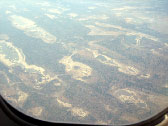 (although from the plane it made for an interesting geometric pattern). The scattered towns followed an almost European pattern: town buildings were concentrated in tight clusters, maximizing the land available for farming. From the air, these little settlements looked walled, the edges were so well defined. (although from the plane it made for an interesting geometric pattern). The scattered towns followed an almost European pattern: town buildings were concentrated in tight clusters, maximizing the land available for farming. From the air, these little settlements looked walled, the edges were so well defined.
The abandoned land consisted of large areas with beige mounds amid darker soil. These mounds turned out to be extensive stretches of sand dunes created by spring storms from the Gobi Desert. Those Gobi Desert sandstorms shift so much sand that not only are these "wastelands" hundreds of miles outside of Beijing created, but Beijing itself suffers periodic and blinding sandstorms, and, some of the Gobi dust even ends up along the U.S. west coast.
One of the entry forms we had to sign was a Health Declaration. Apparently the Chinese are interested in health of both the physical and emotional kind. The form required passengers to "check the box" if they had any fever, cough, headache, cold or "snivel." No, we had nothing to snivel about; we were quite happy. We didn't have any sniffles, the probable intended word, either.
The changing time zone makes for an interesting night's sleep as we tried to get our bodies to understand when to sleep and when to be awake. We finally surrendered and got up at around 6 am Beijing time. I went for a walk and was struck with the similarity-difference of a very big city getting ready for a work day. Lots of bicycles, and cars, and pedestrians (14 million people in the City), but at least in this part of Beijing, nothing truly "foreign."
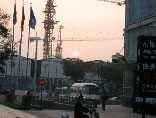 The City is getting ready for the Olympics in 2008 and so building goes on around the clock (all building of new concrete structures must stop by 2007 to let the literal dust settle for the Olympics). Last year, China used some huge percentage of the world's concrete: 35 to 45% (we've heard various numbers). In the meantime, the dawn is hazy and sunrise is eerie red. Pollution. The City is getting ready for the Olympics in 2008 and so building goes on around the clock (all building of new concrete structures must stop by 2007 to let the literal dust settle for the Olympics). Last year, China used some huge percentage of the world's concrete: 35 to 45% (we've heard various numbers). In the meantime, the dawn is hazy and sunrise is eerie red. Pollution.
Tiananmem Square is huge. Like similar grounds around the world, the Square 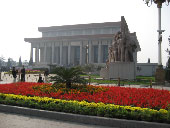 is surrounded by government offices, museums and war memorials while the space in the middle is largely empty. Like Moscow, it is the final resting place for a modern day mummy. (Chairman Mao is preserved and presented to thousands of daily visitors in a crystal coffin in his mausoleum alongside the Square - - the picture to the left.) Crowds are everywhere in Tiananmen, which is no surprise because there are crowds everywhere in Beijing. It is difficult to get distance shots of the various impressively massive spaces of the present and past rulers because the air pollution is terrible. Every picture looks like it is taken in the rain. Tiananmen is also across from one of the four entrances of the Forbidden City (one entrance at each point of the compass). is surrounded by government offices, museums and war memorials while the space in the middle is largely empty. Like Moscow, it is the final resting place for a modern day mummy. (Chairman Mao is preserved and presented to thousands of daily visitors in a crystal coffin in his mausoleum alongside the Square - - the picture to the left.) Crowds are everywhere in Tiananmen, which is no surprise because there are crowds everywhere in Beijing. It is difficult to get distance shots of the various impressively massive spaces of the present and past rulers because the air pollution is terrible. Every picture looks like it is taken in the rain. Tiananmen is also across from one of the four entrances of the Forbidden City (one entrance at each point of the compass).
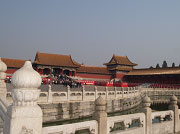 The Forbidden City also earns the appellation of huge. One measure is that we walked for about three hours across the Square and through the City not doing much but glancing around. The City was built in the 1400's and used until the early 1900's. Each emperor added to the complex. The core of the City was a living quarters for the emperor and his wives/concubines (as many as 40 wives for one of the emperors). Each wife (there were five ranks of wives) had her own apartment and quarters for her servants and children. By the time all this living space was created and ceremonial facilities constructed, the City spread out over hundreds of acres. The marble, tile, and painted wood created a sizable city within a city. The Forbidden City also earns the appellation of huge. One measure is that we walked for about three hours across the Square and through the City not doing much but glancing around. The City was built in the 1400's and used until the early 1900's. Each emperor added to the complex. The core of the City was a living quarters for the emperor and his wives/concubines (as many as 40 wives for one of the emperors). Each wife (there were five ranks of wives) had her own apartment and quarters for her servants and children. By the time all this living space was created and ceremonial facilities constructed, the City spread out over hundreds of acres. The marble, tile, and painted wood created a sizable city within a city.
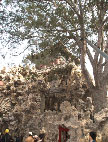
The Forbidden City has a park which was used for the pleasure of the emperor and his family. It is different from any park I have ever seen. In its own way, it is both beautiful and at the same time eerie. One structure, a rock formation with a pagoda on top, was just for the emperor to view the full moon. The trees are old and shaped as if they were bonsai.
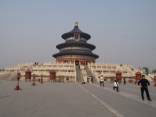 From the Forbidden City we went to the Temple of Heaven, which is another massive structure sprawling over hundreds of acres. It was used only twice a year and only by the emperor to pray for rain and for a good harvest. The Temple is circular because the Chinese believed that the universe was round (they believed that the earth was square). The Temple has three roofs because three roofs stood for heaven, two roofs for the emperor, and one roof for everyone else. TheTemple is surrounded by trees planted when it was built (around 1420), and they are gnarled and wildly shaped. From the Forbidden City we went to the Temple of Heaven, which is another massive structure sprawling over hundreds of acres. It was used only twice a year and only by the emperor to pray for rain and for a good harvest. The Temple is circular because the Chinese believed that the universe was round (they believed that the earth was square). The Temple has three roofs because three roofs stood for heaven, two roofs for the emperor, and one roof for everyone else. TheTemple is surrounded by trees planted when it was built (around 1420), and they are gnarled and wildly shaped.
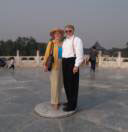 Western culture and religion believed that the Earth was the center of the universe. As the Middle Kingdom (the kingdom in the center of everything) the Chinese went a step further. Not only was China the center of things on earth, the Temple of Heaven grounds has a structure considered to represent the universe. The stone we are standing on was considered to be the "center of the universe." In other words, China has it all, and from the building activity around here, that is exactly right. Western culture and religion believed that the Earth was the center of the universe. As the Middle Kingdom (the kingdom in the center of everything) the Chinese went a step further. Not only was China the center of things on earth, the Temple of Heaven grounds has a structure considered to represent the universe. The stone we are standing on was considered to be the "center of the universe." In other words, China has it all, and from the building activity around here, that is exactly right.
|